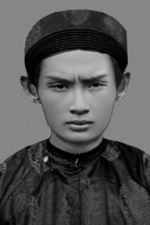Chen Minko
Saint Chen Minko | |
|---|---|
秦敏柯 | |
 | |
| Born | September 9, NMR 2170 |
| Disappeared | NMR 2226 (age 56) |
Chen Minko (born NMR 2170), also known as Saint Chen (秦聖, Chensan) or the Last Saint (終聖, Sunsan) is the founder of Kansism and a rebel leader who led an uprising against the Hao dynasty.
Born in Xhiyun Province (present-day West Nozama), Chen passed the imperial examinations and became the governor of Kung County, where his hometown of Gukmo was located. He fell out with Hao authorities after an inspector visiting the county accused him of corruption and stripped him of his position. Chen went into exile in the mountains, where he is said to have received revelations from God. He returned from the mountains as a preacher, claiming that there is one almighty God who had manifested himself during several points in time to deliver revelations that can save humankind if they are universally accepted as truth. Chen's teachings earned widespread popularity, especially among the peasants and poor who were attracted by Chen's calls for universal salvation and equality.
The Hao initially tolerated Kansism but turned against it after Chen claimed that the Emperor of Namor is not the Son of Heaven because God did not have blood relatives. The Hao army pillaged dozens of villages and killed thousands of Kansists in search of Chen. In response, Chen announced that the Hao dynasty had lost all legitimacy and waged rebellion against it. Kansist rebels captured Nozama City and declared it the capital of the Kansist State with Chen as its leader. The rebellion quickly spread to other parts of the country; however, infighting caused the Kansists to weaken until the Hao recaptured Nozama City. Chen continued to lead his followers in waging guerrilla warfare against Hao troops until his disappearance in NMR 2226.
Since Chen's disappearance, scholars have proposed various theories regarding his whereabouts. One theory claims that Chen committed suicide after suffering a series of defeats at the hands of Hao authorities; while the place and time of Chen's suicide are disputed, historians consider the suicide theory to be more probable than all others, barring the discovery of evidence to the contrary. Another theory claims Chen went into hiding to escape persecution, either in the remote parts of Namor or overseas - an assertion that was endorsed by the revolutionary Jacob Cho, a Kansist who claimed to have seen Chen in Ainin. Kansists believe Chen disappeared to protect himself from dangers to his life, and will reappear when Kansism is universally accepted as truth.
Biography
Most information concerning Chen's life either come from official sources that are heavily biased against Chen, or Kansist sources that regard Chen as a saint. As a result, myths surrounding Chen's life are oftentimes indiscernible from the facts.
Early life
Chen was born in the village of Gukmo in Xhiyun Province (present-day West Nozama), in September 9, NMR 2170. The Tinsek, one of Kansism's two holy texts, claims the villagers of Gukmo witnessed various natural phenomena prior to Chen's birth.
Coming from an affluent peasant family, Chen was able to attend school and become educated in literature and politics. He took part in the imperial examinations, in which he received a high mark and was appointed governor of Kung County. However, his governorship would not last long; during a visit to the county by a Hào inspector, he was accused of corruption, stripped of his title and evicted from the county. According to official Hào records, Chen was caught withholding an excessive amount of taxes from locals, a portion of which should have been transferred to the imperial government. However, Kansists say Chen was actually removed from his post because he was a Kannei, whilst the Hào authorities - who were Tuhaoese - feared Chen's governorship would undermine Tuhaoese dominance in Xhiyun.
Founding of Kansism
After Chen was expelled from Kung County, he sought refuge in the Hongtsao Mountains, where he lived as a hermit for eight years. Kansists believe that it was at the Hongtsao Mountains where Chen received the revelations from God that would form the tenets of Kansism. According to Kansist texts, Chen saw Nushen, Jesus Christ and the authors of the Declaration of the Rights of the People in a dream. They revealed themselves as past manifestations of God before informing Chen that he was God's last manifestation on Earth, tasked with delivering the last of God's revelations to the world. Upon receiving the revelations, Chen woke up and put the revelations on paper, composing the Heavenly Scripture, or Tinsek.
Chen left his hermitage to preach his newly acquired ideas. It is said that he performed miracles such as healing the sick and conducting seances that earned him many followers, although historians say his messages of universal salvation and equality made him attractive.